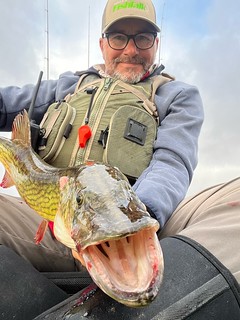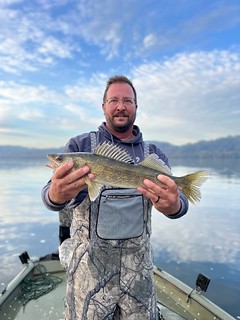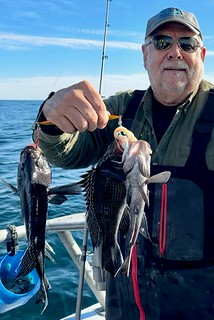Maryland Fishing Report – December 6
Welcome to December, there are some wonderful fishing opportunities to be found this week for many anglers fishing close to home. The chain pickerel stands out for pure fun and excitement.
This will be the final weekly Maryland Fishing Report for 2023. We will be checking in with occasional winter reports and look forward to starting again weekly in spring. On behalf of all of us at DNR, we wish you a joyful holiday season and a healthy and happy 2024!
As a reminder, striped season in the Chesapeake Bay and tributaries closes Saturday, December 10. Look for the Maryland Department of Natural Resources’ announcement of seasons and limits for 2024 sometime over the winter. In response to five years of below average spawning success for striped bass, DNR is submitting emergency regulations to help bolster the species’ spawning population. We all share the goal of making sure striped bass fishing is available for future generations of Marylanders.
Forecast Summary: December 6 – December 12:
The upcoming week should continue to provide cool temperatures all week, with windy and possibly rainy conditions on Wednesday and Sunday. Bay surface water temperatures have dropped to the mid to upper 40s moving from the upper Bay down to the Virginia state line. Salinity is slightly higher than average and there are suitable oxygen conditions down to the bottom in all areas of Maryland’s portion of the Bay. With rivers running in the low 40s, baitfish have moved out of the rivers to the warmer bottom waters. Anglers may want to focus on these deeper channel areas for fish settling into their overwintering areas in the deeper, warmer bottom waters of the main bay near such structures as channel edges, underwater points, hard bottom, and drop-offs. In addition, warm water discharges from power plants will also provide areas for anglers to check for gamefish.
Expect average flows in Maryland rivers and streams all week. There will be above average tidal currents Saturday through Tuesday as a result of the upcoming new moon on December 13. Expect average water clarity for most of Maryland’s Bay, rivers, and streams. To see the latest water clarity conditions, check Eyes on the Bay Satellite Maps.
As always, the best fishing areas could be further refined by intersecting them with underwater points, hard bottom, drop-offs, and large schools of baitfish. For more detailed and up-to-date fishing conditions in your area of the Bay, be sure to check out Eyes on the Bay’s Click Before You Cast.
Anglers in the lower Susquehanna River are catching smallmouth bass and walleye on soft plastic jigs, small crankbaits, and paddletails. A mix of blue catfish and channel catfish are biting well in the lower Susquehanna and nearby tidal rivers and channels. Fresh cut bait is one of the most popular baits when fishing for catfish, but chicken liver and scented baits also work well.
White perch are being found in the deeper channel areas in the lower sections of the region’s tidal rivers and out in the Bay holding close to hard bottom. Using bottom rigs baited with pieces of bloodworm is one of the most popular ways to fish for them but dropper rigs with a sinker or heavy jig works well. Depending on whether a jig or sinker is used, one or two small flies of soft plastic jigs work well. Anglers are reminded that no more than two separate hooks or lures are allowed when fishing in Maryland.
Water temperatures in the upper Bay and the region’s tidal rivers are now in the mid-40s so striped bass and white perch are going deep seeking slightly warmer water temperatures. Anglers are starting to find fewer striped bass willing to feed aggressively. Jigging is still an option in the lower Chester River, around the Love Point rocks and the mouth of the Patapsco and Magothy rivers. Skirted soft plastic jigs are a popular lures.
Trolling with umbrella rigs or tandem rigger swimshads or bucktails behind heavy inline weights is a good option this week. The heavy weight is needed to get down to the depths where striped bass are suspended close to the bottom of the channels.
Water temperatures in the middle Bay are in the upper 40s this week, and the tidal rivers are in the mid 40s. Striped bass are becoming lethargic and are seeking slightly warmer water temperatures in the deeper waters of the main channels. They tend to be holding close to the bottom.
Jigging with soft plastic jigs of an ounce or more along the deeper channel edges is working for anglers when they can find concentrations of fish. The concrete abutments at the Bay Bridge are often worth a look as are Eastern Bay near Tilghman Point, the False Channel at the mouth of the Choptank River, and the deep edge off Thomas Point.
A popular way to fish this week is trolling umbrella rigs or tandem rigged bucktails and swimshads behind heavy inline weights in the main channels of the Bay and at the mouths of the major tidal rivers. The depths where striped bass are holding start at about 30 feet to as deep as 60 feet in the shipping channel. The striped bass tend to stack up along the steeper channel edges and are suspended close to the bottom.
White perch are now holding in the deeper waters at the mouths of the region’s tidal rivers. They can also be found holding over hard bottom out in the Bay – one such location is off Matapeake on the Eastern Shore. The rock piles at the Bay Bridge are a good place to look for large white perch holding tight to the rocks in the swift current. It will take small but very heavy jigs to reach them without your lure being swept away in the stiff current before reaching the depths where the white perch are holding.
Fishing for channel catfish is good this week in the upper sections of the region’s tidal rivers. Blue catfish can be found in the Choptank River from the Dover Bridge area upriver to above the town of Denton. Fresh cut bait, chicken liver or scented baits work well on a simple bottom rig or a circle hook and sliding egg sinker rig.
The lower Potomac River’s steep channel edges continue to be a draw for striped bass anglers this week. The steep edge from St. Clements State Park to St. Georges Island is a good place to find striped bass holding close to the bottom in about 30 feet of water. The steep edge near Ragged Point on the Virginia side of the river is also a good place to look for striped bass.
Jigging with soft plastic jigs, skirted or not, are the most popular lures used when jigging. Trolling is a time-proven fall technique when striped bass are holding deep. Umbrella rigs or tandem rigged swimshads and bucktails are pulled behind heavy inline weights, which are needed to reach the depths where the striped bass are holding.
The lower Patuxent River and the channel edges from Cedar Point to Cove Point are a good place to look for striped bass holding in about 30 feet of water this week. The channel edge on the east side of the Bay near the HS Buoy is also holding good numbers of striped bass. A variety of soft plastic lures are the favored choice of most anglers who are jigging in blends of chartreuse and white. Skirts of chartreuse, yellow, and orange give a larger profile.
With Bay water temperatures dipping into the 40s, the Calvert Cliffs Nuclear Power Plant warm water discharge is always worth a few drifts while jigging. It is a favored spot to check for large speckled trout as well as striped bass this time of the year.
White perch are now holding in about 25 feet of water or more at the mouths of the major tidal rivers within the lower Bay. The lower Patuxent River is a very popular location to fish for them as is Tangier Sound. Bottom rigs baited with pieces of bloodworm is a very popular way to fish for them. Other anglers have good luck with dropped rigs.
Fishing for blue catfish is taking center stage for many anglers this month. The largest blue catfish can be found in the deeper channels such as the channel off Fort Washington State Park on the Potomac River or the Jug Bay area on the Patuxent. The Nanticoke River has a large population of blue catfish, and many are now in the 50-pound category. Medium-sized blue catfish can be found in slightly shallower waters along the edges of the channels. The freshest cut bait you can find makes the best baits, gizzards shad, menhaden, white perch, bluegill sunfish and eels all make good baits. Blue catfish trophy anglers often use live bait in the form of bluegill sunfish, white perch, or goldfish.
Fishing for smallmouth bass and walleye has been good – cooler water temperatures always get these two fisheries going and they should last through much of the winter. Deep Creek Lake, Prettyboy Reservoir, and the upper Potomac and lower Susquehanna rivers are excellent places to fish for smallmouth bass. Deep Creek Lake, the upper Potomac and the lower Susquehanna hold good populations of walleye. Most anglers like to use root beer-colored tubes and a mix of soft plastic swimbaits, and crankbaits for smallmouth bass; and soft plastic jigs, swimbaits, jerkbaits, and small crankbaits for walleye.
Trout fishing in many of the specialized trout management waters is very good this week for those who enjoy catch-and-release and fly fishing. The preseason stocking of trout will begin soon, so trout anglers should start checking the DNR trout stocking website.
Largemouth bass are beginning to feel the effects of colder water temperatures and are generally holding in depths of six feet or more. with moving even deeper. Structure is a key item to focus on this time of the year. Sunken wood, steep drop-offs, bridge piers, and rocks are all worthy of extra attention when largemouth bass fishing.
Small, slow, and close to the bottom is your mantra when fishing for sluggish largemouth bass in colder waters. Wacky rigged worms worked slow and deliberate near structure is a proven tactic, pickups by largemouth bass will be subtle. Blade lures are a good lure to use in the deepest waters; slow-rolling a spinnerbait across the bottom can also work well. Craw jigs and small crankbaits worked very slowly along the bottom is another good tactic.
Fishing for crappie is good this week, and they can be found schooled up near deep structure. Sunken brush, bridge piers, marina docks, and fallen treetops all fit the bill. Slowly working a small minnow or marabou jig under a slip bobber near the structure usually works well.
The cold winter months and fishing for chain pickerel go hand-in-hand. Anglers are having fun targeting the fish along shoreline sunken wood or deeper wood such as tree stumps in flooded reservoirs. The upper sections of the Bay’s tidal rivers is a great place to find chain pickerel, often near docks, pilings and fallen trees.
Anglers fishing with small minnows and Beetle-Spins will start to encounter yellow perch in the middle to upper sections of the Bay’s tidal rivers and creek. The fish tend to wander farther up the waterways when water temperatures are as cool as they are. When water temperatures dip below 40 degrees they will travel down river to deep holes and channels where they will hold until warming spring temperatures bring on the urge to head upriver to spawn.
The southward migration of large striped bass has finally entered Maryland waters this week, but a large portion of these fish will unfortunately be moving through waters beyond the 3-mile mark off Maryland’s shores and into the U.S. Exclusive Economic Zone. Most of these fish will also far exceed the maximum legal length of 31 inches to keep one. Some of these fish will surely pass along the beaches and ardent surf casters will enjoy the action.
At the Ocean City Inlet there is no shortage of striped bass for anglers to enjoy. Most of the striped bass being caught fall short of the 28-inch minimum but provide plenty of fun catch-and-release fishing. Casting soft plastic jigs and paddletails is the most popular way to target them. They can also be found near the Route 90 and Verrazano bridges.
Each day more and more tautog are being caught in the inlet and Route 50 Bridge area and many are exceeding the 16-inch minimum, making anglers very happy. Pieces of green crab or sand fleas are the most popular baits.
The boats taking anglers to the offshore wreck and reef sites are finding limit catches of black sea bass for their anglers onboard. Other charters are now targeting tautog and some impressive catches are being reported.
Bluefin tuna are moving through our area, usually within the 30-Fathom curve and as close as 5 miles or so. Most of the time they will be seen pushing water as they swim relatively close to the surface and tend to have no interest in the offerings of anglers, whether they try casting or trolling. There is a way to entice a bluefin to take a lure while swimming within a migrating school – use a No. 4 stainless steel Drone spoon, rigged on 16 feet of No. 7 wire for bluefins in the 50-125 pound size. Get ahead of the school at about a 100 yards and start to pace with the school while someone pays out line till; the fish believe the Drone spoon is within the school. Then start jigging sideways and bam – you should hook up with a fish. This has worked time and time again and please note, no other spoon will work, only that No. 4 Drone in stainless.
“There is the feeling of wonderful contentment a man can have on a lonesome beach that is chilling itself up for winter, sort of practice-swinging to get ready for the bitter cold that’s coming.” – Robert Ruark
Maryland Fishing Report is written and compiled by Keith Lockwood, fisheries biologist with the Maryland Department of Natural Resources.
Click Before You Cast is written by Tidewater Ecosystem Assessment Director Tom Parham.
This report is now available on your Amazon Echo device — just ask Alexa to “open Maryland Fishing Report.”





